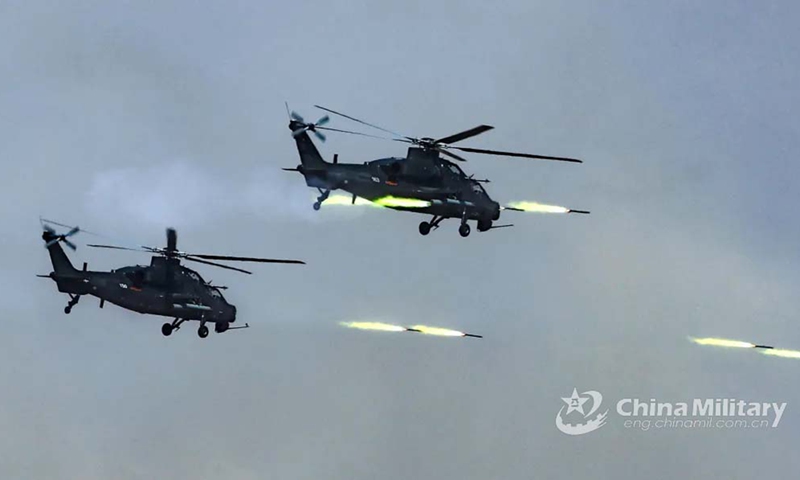
An armed helicopter fleet launches an assault on the defense works and firing points of the mock terrorists during the low-altitude defense penetration operations in the China-Russia joint military exercise ZAPAD/INTERACTION-2021 at a training base of the PLA Army in Qingtongxia City of West China's Ningxia Hui Autonomous Region from August 9 to 13, 2021. Photo: eng.chinamil.com.cn/Wang Weidong
The Chinese People's Liberation Army (PLA) revealed many details of the country's domestically developed Z-10 attack helicopter in a recent program aired by the state broadcaster, introducing its outstanding, unique capabilities in modern warfare against tanks, infantry and other choppers.
As the first type of attack helicopter domestically developed by China, the Z-10 has been commissioned by the PLA in large numbers in recent years, including an aerial assault brigade affiliated with the 83rd Group Army, China Central Television (CCTV) reported on Monday.
With a range of 1,120 kilometers, the Z-10 has an empty weight of about 5,100 kilograms. It has four external hardpoints that can carry air-to-ground and air-to-air missiles as well as rockets, plus a 23 millimeter caliber revolver gun, according to CCTV's report.
The helicopter can be armed with up to 16 anti-tank missiles, four 7-barrel multiple rocket launchers or two 32-barrel multiple rocket launchers. For different missions, different configurations will be used. For example, missiles will be used against armored vehicles and tanks, and rockets and the gun will be used against infantry targets, Zhang Zhengfei, an ace pilot at the brigade, told CCTV.
When attacking a hostile tank group, the Z-10 will usually carry eight air-to-ground missiles and two multiple rocket launchers, Zhang said, explaining that the missile has an accuracy of 85 percent and each Z-10 sortie can at least destroy six enemy tanks.
A standard group of four Z-10s can carry 32 anti-tank missiles, eight 57 millimeter caliber multiple rocket launchers and four guns, and this is enough to wipe out three tank companies, CCTV said.
The Z-10 can also launch the 50 kilogram-class TY-90 air-to-air missile against hostile helicopters, the report mentioned.
For defense, the helicopter is also equipped with armor made of composite materials that have a protective capability which far surpasses the strength of titanium alloy or steel, CCTV reported, noting that the materials are also lighter.
The pilot of the Z-10 uses a specially made helmet that can display all key parameters and battlefield dynamics directly onto the visor. The pilot can even use the helmet to aim, as the weapons will point to wherever the pilot is looking to through the helmet, according to the report.
Thanks to its good aerodynamic design, domestically made engines, excellent handling and maneuverability, the Z-10 is easier to control, has a longer range and a better multi-tasking capability than its foreign counterparts, like the Eurocopter Tiger, CCTV mentioned.
In October, the Z-10 helicopter was spotted in PLA exercises
near the island of Taiwan for the first time.
Fu Qianshao, a Chinese military aviation expert, told the Global Times that the Z-10 has very strong firepower and world-class avionics systems, and it can attack both ground, sea and air targets.
The Z-10 can play a unique role in amphibious landing missions, Fu said.
Having a record of operations in Northwest China's high-altitude desert regions and Southwest China's Qinghai-Xizang Plateau, the Z-10 can also handle China's high-elevation border regions, observers said.




